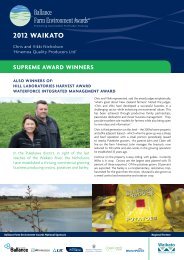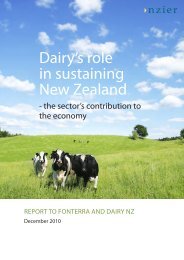NZIER report on compensation for transmission infrastructure
NZIER report on compensation for transmission infrastructure
NZIER report on compensation for transmission infrastructure
You also want an ePaper? Increase the reach of your titles
YUMPU automatically turns print PDFs into web optimized ePapers that Google loves.
1. Background<br />
New Zealand electricity is generated at hydro, thermal, geothermal and wind power<br />
stati<strong>on</strong>s scattered throughout the North Island and hydro and wind power stati<strong>on</strong>s in<br />
the South Island. Load is at highly populated areas, generally in the North Island<br />
while generati<strong>on</strong> capacity is in lightly populated areas, with hydro storage mainly in<br />
the South Island. As a c<strong>on</strong>sequence there is approximately 12,000 kilometres 1 of<br />
transmissi<strong>on</strong> <strong>infrastructure</strong> in New Zealand linking generati<strong>on</strong> capacity and storage<br />
with commercial, industrial and residential end users. The majority of transmissi<strong>on</strong><br />
towers and lines are <strong>on</strong> and over private property, predominantly land used <strong>for</strong><br />
farming. 2<br />
Transpower was established as a State Owned Enterprise in 1987 to own and<br />
operate the nati<strong>on</strong>al electricity transmissi<strong>on</strong> grid, having been mandated the<br />
resp<strong>on</strong>sibility of transmitting electricity in New Zealand. Transpower ownership of and<br />
access to transmissi<strong>on</strong> <strong>infrastructure</strong> <strong>on</strong> private land is covered under statutory<br />
provisi<strong>on</strong>s, in effect an eminent domain 3 <strong>for</strong> lines built prior to 1988 (about 95% of all<br />
lines), and easements or similar rights <strong>for</strong> lines c<strong>on</strong>structed post 1988. 4 Pre 1988<br />
<strong>infrastructure</strong> was built by the public sector with rights of ownership and access<br />
transferred to Transpower in 1988. Transpower‟s rights to both pre and post 1988<br />
<strong>infrastructure</strong> include ownership or, where it does not own land, access <strong>for</strong><br />
inspecti<strong>on</strong>, operati<strong>on</strong>s and maintenance. These rights bind successive title holders. 5<br />
1.1 Compensati<strong>on</strong><br />
Anecdotal evidence suggests that there was no standard approach to compensating<br />
farmers <strong>for</strong> transmissi<strong>on</strong> <strong>infrastructure</strong> built <strong>on</strong> their land prior to 1988. It appears that<br />
in some cases landowners received a small financial or other <strong>on</strong>e-off payment in kind<br />
(such as having an access track built). In other cases landowners received no<br />
compensati<strong>on</strong> <strong>for</strong> the <strong>infrastructure</strong> built <strong>on</strong> their property.<br />
Currently when Transpower wants to build new <strong>infrastructure</strong> and cannot or does not<br />
wish to purchase the required land, it is obliged to negotiate an easement with the<br />
landowner. In the event that negotiati<strong>on</strong>s are unsuccessful the enterprise can apply<br />
to acquire land under The Public Works Act 1981. This opti<strong>on</strong> of compulsory<br />
purchase is seen as necessary, partially because of the nati<strong>on</strong>al interest functi<strong>on</strong> of<br />
transmissi<strong>on</strong> lines and partially to prevent landowners from attaining m<strong>on</strong>opoly<br />
powers and stopping a line from being completed or excessively inflating costs.<br />
1 Transpower at http://www.transpower.co.nz/transporting-power<br />
2 In urban areas transmissi<strong>on</strong> <strong>infrastructure</strong> is often beside roads rather than being built <strong>on</strong> private<br />
land.<br />
3 Eminent domain is a power provided by the State to utilities allowing them to expropriate or take<br />
a citizen‟s property rights with compensati<strong>on</strong>.<br />
4 An easement is a “n<strong>on</strong>-possessory” right to use another party‟s property.<br />
5 Transpower landowner‟s manual.<br />
<str<strong>on</strong>g>NZIER</str<strong>on</strong>g> – Compensati<strong>on</strong> <strong>for</strong> transmissi<strong>on</strong> <strong>infrastructure</strong> 7
















